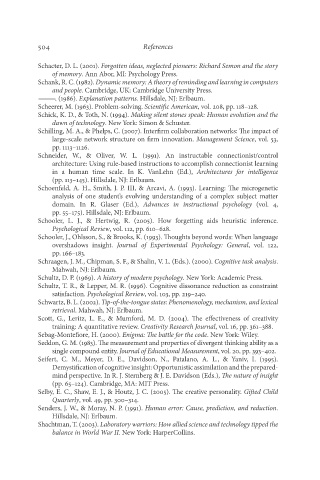Page 521 - Deep Learning
P. 521
504 References
Schacter, D. L. (2001). Forgotten ideas, neglected pioneers: Richard Semon and the story
of memory. Ann Abor, MI: Psychology Press.
Schank, R. C. (1982). Dynamic memory: A theory of reminding and learning in computers
and people. Cambridge, UK: Cambridge University Press.
———. (1986). Explanation patterns. Hillsdale, NJ: Erlbaum.
Scheerer, M. (1963). Problem-solving. Scientific American, vol. 208, pp. 118–128.
Schick, K. D., & Toth, N. (1994). Making silent stones speak: Human evolution and the
dawn of technology. New York: Simon & Schuster.
Schilling, M. A., & Phelps, C. (2007). Interfirm collaboration networks: The impact of
large-scale network structure on firm innovation. Management Science, vol. 53,
pp. 1113–1126.
Schneider, W., & Oliver, W. L. (1991). An instructable connectionist/control
architecture: Using rule-based instructions to accomplish connectionist learning
in a human time scale. In K. VanLehn (Ed.), Architectures for intelligence
(pp. 113–145). Hillsdale, NJ: Erlbaum.
Schoenfeld, A. H., Smith, J. P. III, & Arcavi, A. (1993). Learning: The microgenetic
analysis of one student’s evolving understanding of a complex subject matter
domain. In R. Glaser (Ed.), Advances in instructional psychology (vol. 4,
pp. 55–175). Hillsdale, NJ: Erlbaum.
Schooler, L. J., & Hertwig, R. (2005). How forgetting aids heuristic inference.
Psychological Review, vol. 112, pp. 610–628.
Schooler, J., Ohlsson, S., & Brooks, K. (1993). Thoughts beyond words: When language
overshadows insight. Journal of Experimental Psychology: General, vol. 122,
pp. 166–183.
Schraagen, J. M., Chipman, S. F., & Shalin, V. L. (Eds.). (2000). Cognitive task analysis.
Mahwah, NJ: Erlbaum.
Schultz, D. P. (1969). A history of modern psychology. New York: Academic Press.
Schultz, T. R., & Lepper, M. R. (1996). Cognitive dissonance reduction as constraint
satisfaction. Psychological Review, vol. 103, pp. 219–240.
Schwartz, B. L. (2002). Tip-of-the-tongue states: Phenomenology, mechanism, and lexical
retrieval. Mahwah, NJ: Erlbaum.
Scott, G., Leritz, L. E., & Mumford, M. D. (2004). The effectiveness of creativity
training: A quantitative review. Creativity Research Journal, vol. 16, pp. 361–388.
Sebag-Montefiore, H. (2000). Enigma: The battle for the code. New York: Wiley.
Seddon, G. M. (1983). The measurement and properties of divergent thinking ability as a
single compound entity. Journal of Educational Measurement, vol. 20, pp. 393–402.
Seifert, C. M., Meyer, D. E., Davidson, N., Patalano, A. L., & Yaniv, I. (1995).
Demystification of cognitive insight: Opportunistic assimilation and the prepared-
mind perspective. In R. J. Sternberg & J. E. Davidson (Eds.), The nature of insight
(pp. 65–124). Cambridge, MA: MIT Press.
Selby, E. C., Shaw, E. J., & Houtz, J. C. (2005). The creative personality. Gifted Child
Quarterly, vol. 49, pp. 300–314.
Senders, J. W., & Moray, N. P. (1991). Human error: Cause, prediction, and reduction.
Hillsdale, NJ: Erlbaum.
Shachtman, T. (2003). Laboratory warriors: How allied science and technology tipped the
balance in World War II. New York: HarperCollins.

